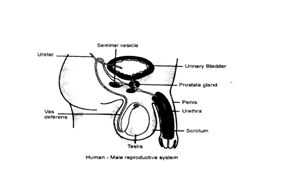9.3 SHORT QUESTIONS :
1. When is reproduction said to be sexual.
Ans: The mode of reproduction in which a male and a female gamete fuse to produce a zygote is called sexual reproduction.
2. What is metamorphosis Give examples.
Ans: The drastic change which takes place during the development of an animal is called metamorphosis. Silkworm and frog undergo metamorphosis.
3. Differentiate between internal fertilisation and external fertilisation.
Ans :
| Internal Fertilisation | External Fertilisation |
| (a) Fertilisation that takes place inside the female body. (b) Takes place in humans, cows, hens and dogs. |
(a) Fertilisation that takes place outside the female body. (b) Takes place in frogs, fishes and starfish. |
4. Explain the importance of reproduction in organisms.
Ans: Reproduction is essential for the survival of organisms. It ensures the continuation of similar kinds of individuals, generation after generation.
5. Differentiate between sexual and asexual reproduction.
Ans:
| Sexual Reproduction | Asexual Reproduction |
| (a) Reproduction which takes place by the fusion of male and female gametes. (b) Takes place in humans, cow. |
(a) Reproduction in which only a single parent is involved. (b) Takes place in hydra and amoeba. |
6. How many sperms are produced by the testis.
Ans: Millions of sperms are produced by the testis.
7. What is the function of ovaries, in human beings, how many eggs are produced every month.
Ans: Ovaries produce female gametes called ova. In human beings, a single mature egg is released every month.
8. If millions of sperms are transferred from the male to the female body, how many fuse with the egg.
Ans: Only one sperm fuses with the egg.
9. Draw a diagram to show fertilisation in humans.
Ans:

10. What is a zygote?
Ans: A fertilized egg is called Zygote.
11. How does the size of the egg varies in different animals.
Ans: The egg is very small in humans, much larger in hens and the largest in ostrich.
12. The eggs of a frog are covered by a layer of jelly. Why.
Ans: The layer of jelly protects the eggs and holds them together.
13. What is binary fission.
Ans: Binary fission is a mode of reproduction in unicellular organisms by which a single individual divides into two parts and each part live as two independent individuals.
14. Name any two animals that undergo metamorphosis.
Ans: Silkworm and frog
15. What is fertilisation. Differentiate between external and internal fertilisation.
Ans: Fusion of male sperms and female ova is called fertilisation.
Differences:
| External fertilisation | Internal fertilisation |
| i) When male gamete fuses with the female gamete outside the body of female, e.g. In fishes and frogs. |
i) When male gamete fuses with the female gamete inside the body of female, e.g. In dogs and human beings. |
16. What do you mean by viviparous animals.
Ans: Viviparous animals are the animals which give birth to their young ones.
17. Draw a labelled diagram to show the male reproductive system in human beings.
Ans:

18. Draw a labelled diagram to show the female reproductive system in human beings.
Ans:

19. Explain how external fertilisation takes place in frogs.
Ans: During rainy season, frogs and toads move to ponds. When the male and female come together in water, the female lays hundreds of eggs. A layer of jelly holds the eggs together. The male deposits the sperms over them and fertilisation takes place.
20. Name an organism that reproduces by budding.
Ans: Hydra.
21. Name any two methods of asexual reproduction.
Ans: Budding and Binary fission.

